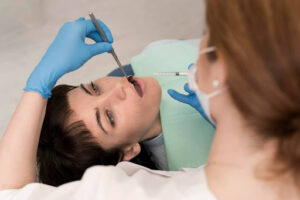


When you are weighing up dental implants, it is reasonable to ask how much it will hurt. Clear, kind dentistry means being honest about what you are likely to feel and how we keep you comfortable. Most people describe the experience as manageable. With modern local anaesthetics, gentle technique and sensible aftercare, discomfort is usually mild and short-lived.
Below, you will find a straightforward explanation of what to expect during treatment and in the days that follow, plus practical steps to keep recovery smooth.

Implants are placed under local anaesthesia. This numbs the area, so you should not feel pain while the implant is inserted. You may notice pressure, vibration from the handpieces and a sense of gentle tugging as the implant is positioned. If you are particularly anxious, conscious sedation can be considered for suitable cases, in line with NHS England’s standards for safe anxiety management in dentistry. See the clinical guidance on dental anxiety management.
A straightforward single implant is often placed in under an hour once you are numb. More complex cases can take longer, especially if bone grafting is planned. Your clinician will outline timings at the consultation so you can plan the rest of the day.
Some soreness once the numbness fades is normal. Most people manage very well with standard over-the-counter pain relief and simple home care. The NHS guide to recovering after a dental implant explains that swelling and bruising typically peak within the first couple of days and then settle, with discomfort usually easing over the first week.

If grafting or a sinus lift has been carried out, expect a longer period of awareness in the area. This should still be manageable with routine measures.
If you are replacing a single missing tooth, our guide to single tooth implants explains the step-by-step process, comfort measures and aftercare, and you can book your consultation when you are ready.
Pain is personal, but many patients say an implant feels no worse than an extraction and is often easier than expected. Here is a simple comparison to give you a sense of scale.
|
Treatment |
During the appointment |
First 72 hours |
Typical patient comment |
|
Dental implant (single, straightforward) |
Numb, pressure and vibration only |
Mild to moderate ache, possible swelling or bruising, responds to standard pain relief |
More uncomfortable than painful, better than expected |
|
Tooth extraction |
Numb, a feeling of pressure, is common |
Similar ache and swelling to an implant, socket tenderness |
Achey but manageable |
|
Root canal treatment |
Numb, minimal sensation |
Usually mild tenderness when biting |
Hardly any pain afterwards |
This table is a general guide. Your clinician will tailor expectations to your case.
Front teeth often sit in thinner bone and may need delicate grafting, yet the procedure is still designed to be comfortable. Molars can require a little more pressure during placement because the bone is thicker. Additional procedures, such as grafting or sinus lift, can increase short-term swelling, but this is anticipated and planned for in your aftercare.
Healthy gums, good plaque control and a smoke-free recovery tend to support predictable healing. If you clench or grind, a protective guard may be recommended.
Worry can amplify how sensations feel. A calm environment, clear explanations and a simple plan for home care help a great deal. If you are nervous, tell your dentist so we can adapt the appointment to you.
Your dental team will give instructions tailored to your treatment. Common advice includes:
For an overview of how we safeguard standards across the practice, you can read our Healthy & Safety Charter.
Antibiotics are not automatically required for every implant. Your dentist will prescribe them only when clinically indicated.
Problems are uncommon, but you should contact the practice promptly if you notice any of the following:
If anything worries you at any point, our team is here to help. You can reach us through the contact page, and we will advise you.
Feeling apprehensive is very common. Practical steps make a real difference.
NHS England’s standards for anxiety management support the use of behaviour techniques and, where appropriate, conscious sedation in primary care settings. This underpins our approach to caring for more anxious patients.
Once the implant has integrated with the bone, a small connector called an abutment and then the final crown are attached. This appointment is typically comfortable and may need little or no anaesthetic. You might feel slight gum tenderness for a day or two while the tissues settle around the new components.
Many people return to desk-based work the next day after a straightforward single implant. If your role is physical, consider taking an extra day or two and avoid strenuous activity during the early healing phase.
You can usually drive after a local anaesthetic alone. If you have had sedation, you will need someone to take you home and stay with you, and you must not drive for at least 24 hours.
Most tenderness settles within a few days. A slight awareness to firm touch can persist while deeper healing continues, which is normal and not a sign of trouble.
With today’s techniques, most patients experience far less discomfort than they expect. You should feel well numbed during placement, and any after effects are commonly mild, short-lived lived and easy to manage at home. Clear planning, gentle placement and thoughtful aftercare are the keys to a smooth experience and a long-lasting result. If you would like tailored advice or a step-by-step plan, read our overview of implant treatment and then get in touch.
< Back to Blog
All adult patients can opt to join Denplan Essentials from their very first visit. Those wanting more inclusive cover can choose Denplan Care instead. Following an assessment, your dentist will advise which group you will be able to join.
Read MoreMonday
8am – 6pm
Tuesday
8am – 6pm
Wednesday
8am – 6pm
Thursday
8am – 6pm
Friday
8am – 6pm
Saturday
Closed
Sunday
Closed